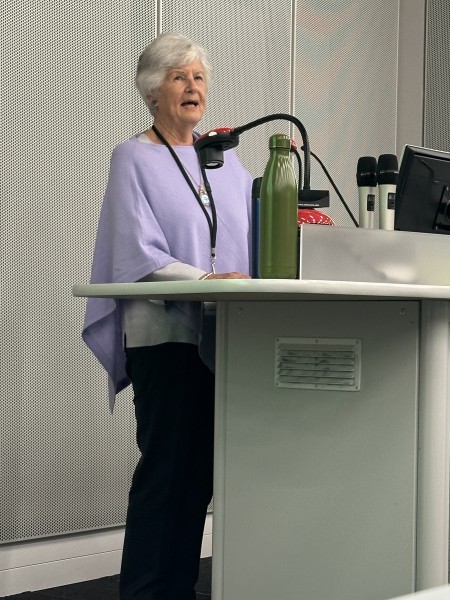9 July 2024
When Stuart Tangye shared a photo of fellow immunologist Franca Ronchese on X recently, he commented, “We are all standing on the shoulders of giants!”

Franca was presenting the 2024 Watson Oration at the Australasian Society for Immunology (ASI) New Zealand branch meeting in Wellington and started her lecture sharing a paper published in 1979 by the oration’s namesake – Jim Watson – the giant to whom Stuart was referring.
At the time, Franca was studying immunology at the University of Padua in Italy, focusing on T-cells before shifting her interest to the dendritic cells she’s so passionate about today. She says the paper – showing that it is possible to grow large numbers of T-cells specific for a certain antigen – stood out from a pile given to her to read by her supervisor, and is one that has stood the test of time.
Jim’s papers were Franca’s first introduction to the New Zealander whose contribution to immunology, science and technology has indeed stood the test of time. In her oration, she went on to share his other influences on her life, including Jim, as a new trustee to the Malaghan Institute in 1993, convincing Graham Malaghan that “immunology was the science to go for” when looking to appoint a new director. That steer led to Franca and her Kiwi husband Graham Le Gros coming to Wellington with their young family in 1994, to lead the institute and its new focus on the immune system. Jim went on to serve on the Malaghan trust board for more than 20 years.
It was in 2010, that members at the ASI New Zealand AGM agreed that Jim’s significant and ongoing contribution to New Zealand immunology and science needed to be acknowledged through a named oration. The following year the inaugural Watson Oration was delivered by John Fraser and Margaret Baird and has since been the highlight of the annual ASI New Zealand branch meeting. Leading New Zealand scientists, including Mike Berridge, Bryce Buddle, Graham Le Gros, Roger Booth, Sarah Hook, Frank Griffin, Anne La Flamme and Joanna Kirman have delivered the prestigious oration over the years, reflecting on Jim’s contribution as well as their own scientific journey and contributions. It has become an important legacy since Jim’s death in 2017 from prostate cancer after a long battle with the disease.
Graham Le Gros, whose PhD in immunology was supervised by Jim at Auckland University says he was a major force in New Zealand science. It was apt then, for the many young scientists who gathered at the ASI New Zealand branch meeting who’d never met him, to hear from Jim’s wife Margaret about the man for whom the prized oration is named.

Margaret Watson
Margaret spoke about Jim’s upbringing on a farm in the Bay of Plenty – riding his horse Nugget to the local country school and enduring a 1.5 hour bus ride to high school in Whakatane after milking the cows at 4am. He was the first in his family to go to university after a difficult conversation with his father turning down a bank manager job he’d lined up for him in Whakatane. Margaret and Jim met at a dance at Auckland University and several years later, after Jim had completed his PhD, headed to the United States for a postdoctoral position, ever mindful of avoiding getting drafted for the Vietnam War.
It was at the Salk Institute in San Diego that Jim’s publishing name – the same name that caught Franca’s attention in 1979 – became a matter of contention, with Nobel Prize winner James Watson (of DNA fame) taking issue at the young scientist from New Zealand sharing his name. Both were James D Watsons – James Dewey Watson and James Douglas Watson. James Senior wanted Jim to publish under J Douglas Watson, but Jim objected, so they settled on JD Watson for Jim.
“A muddle up did occur, though, when both were invited to a symposium in Mexico City,” Margaret recounted. “It was during an epidemic and James Senior had decided not to attend. Imagine Jim’s surprise at being met at the airport by a limo and transported to a luxury villa with a pool planned for the other scientist. The mistake was eventually realised but not before Jim had had a good time with his friends.”
Margaret shared Jim’s extensive scientific career overseas, collaborating with well-known scientists and working in labs in both the United States and Switzerland, before returning home to New Zealand 14 years later. In 1981 he founded the Department of Molecular Medicine at the Auckland Medical School which led to the development of New Zealand’s first biotech company, Genesis Research and Development. The diagnosis of prostate cancer in 2004 gave him incentive to form another research company, Caldera, researching hormonal cancers.
“Science to Jim was a life of curiosity, exploring new ideas, and of great friendship and collaboration truly contributing to knowledge and making the world a better place. There is nothing he would have liked more than to be here with you and listening to the ideas that you are exploring. He is an example of a what can be achieved from humble beginnings when you have vision and the will to achieve it,” said Margaret.
“A good friend once said, ‘Jim is really just a country boy from Te Teko with an intellect too keen and a mind too inquisitive to be held to the land’.”
The Royal Society of New Zealand: James Douglas Wilson (1943 - 2017)
